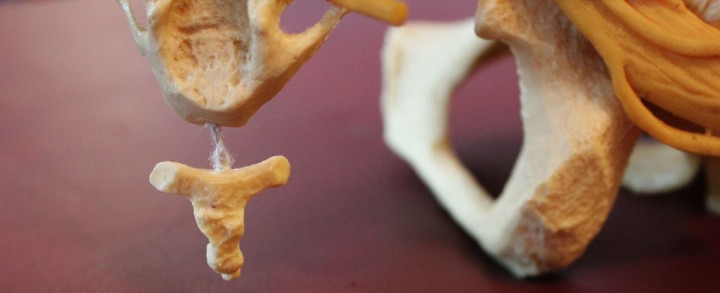Tailbone Pain
Dr. Marc Heller is one of the few chiropractors in the nation offering coccyx adjustment. Become pain-free without unnecessary surgery!

If you suffer from coccyx pain, that is, tailbone pain, you’re not alone. Over the past 18 years, Dr. Marc Heller has treated literally hundreds of people who suffer from pain in their tailbone. For some people, tailbone pain is minor … just an annoyance. But for others, the pain is so debilitating, it’s downright intolerable.
People with severe coccyx pain can’t sit comfortably for any amount of time without being stabbed by a sharp shooting pain. That makes working a desk job, sharing sit-down meals with friends and family, going out to the movies, driving, and biking impossible.
If the pain gets really bad, coccyx sufferers can’t even lie down comfortably, which makes getting a good night’s sleep impossible. It also makes sex difficult, which can put a strain on relationships.
And in the worst cases, the pain is always there. It never goes away, not even for a second.
80% of Coccyx Pain Cases Can be Cured with This Method
The Sherlock Holmes of musculoskeletal diagnosis, Dr. Marc Heller has been practicing chiropractic in the Rogue Valley for over 35 years. A nationally respected expert in tailbone, sacroiliac, and lower back pain, he specializes in chronic cases that are difficult to resolve. Dr. Heller graduated cum laude as valedictorian from the National College of Chiropractic in 1979. He constantly updates his knowledge by studying with different teachers and learning new techniques to help his patients. His work draws from the chiropractic, osteopathic, and physical therapy teachings, with the goal of finding the right techniques for you as a unique individual. His focus is on helping you help yourself; coaching you on how to move better, and how to increase your strength and flexibility. He has published over 120 articles, primarily as a columnist for Dynamic Chiropractic magazine, a national trade journal.

It’s not just physical.
Of course, coccyx pain doesn’t just limit what you can do physically – it may also cause you severe mental anguish, which can manifest in feelings of frustration, anger, depression, and desperation. You may feel embarrassed by standing up when everyone else in the room is sitting or carrying a coccyx cushion with you everywhere you go. Or you might feel shamed by people who figure if they can’t see anything wrong with you, you must be exaggerating it.
Unfortunately, if you go to a conventional medical doctor, chances are they’ll do one of three things: 1) prescribe you drugs to make you stop feeling the pain, which can have some devastating side effects (such as bone loss from corticosteroids); 2) teach you how to “live with the pain,” basically saying it’s never going to go away so you might as well get used to it; or 3) recommend you have expensive surgery to have your coccyx removed, which may or may not solve the problem.
There Is Another Way
I’ve been a chiropractic doctor for more than 30 years. My wife, Beth, and I have dedicated our professional careers to helping people break the patterns of chronic pain. I’ve seen hundreds of patients suffering from the exact type of pain you’re suffering from now. And I’ve developed a method of treating coccyx pain that I’ve seen bring immediate relief to many, many people. – Dr. Marc Heller
Before coming to Dr. Heller, no one had been able to make my tailbone better. Dr. Heller used his adjustment technique on my coccyx, and I had immediate relief. He now adjusts me periodically to help with the coccyx and lower back pain, which is due to degenerative disc injuries. His warmth and sense of humor allowed me to handle the coccyx adjustment, which is an outer and internal adjustment. His staff is friendly and great. He is kind and attentive. —Lori Warfield
Usually, a patient will feel considerable relief after the first treatment. After four to six treatments, their tailbone pain is usually gone – forever. As many as 8 out of 10 patients I treat for coccydynia experience complete resolution of their pain.
Start Moving Towards A Life Without Pain
Why Your Tailbone is Hurting
Coccydnia, or coccyx pain, is usually caused by a fall on a hard surface. It doesn’t matter how it happens. You could hit a pothole on your bicycle, slip on the ice, get thrown from a horse, or just trip over your own front steps. The result is the same: sharp, shooting pain in the tailbone.
Falling isn’t the only way to hurt your tailbone, though. Some women experience coccyx pain after giving birth. Other people get it after being in a car accident. And sometimes, it just seems to come from out of the blue.
In virtually ALL of these cases, though, one thing is the same: The coccyx has been dislocated. It’s jammed forward, which causes all of the soft tissue on the front of the tailbone to lock up, become inflamed, and send pain signals to the brain.
Now, let me ask you something. If you walked into a hospital with a dislocated shoulder, what would the doctors do? Would they prescribe you pain meds and send you on your way? Would they teach you how to live with the pain? Would they suggest that you have your arm removed? Of course not! They’d put your shoulder back into place!
It’s no different with a dislocated coccyx. Your coccyx simply needs to be put back into place. That’s something I can do using a simple series of adjustments.
But I’ve tried chiropractic before, and it didn’t work!
If you’ve tried chiropractic care before, don’t despair. There’s a reason most other chiropractors aren’t able to fix the problem of coccyx pain.
The truth is very few people know how to really assess whether the tailbone is moving properly. They nearly always work from the outside. That means they can’t get your coccyx, which is bent forward, into the proper position. But nearly 100% of the time, you need to get to it from the inside to be able to move it back into place.
I’m fortunate to have trained with some of the world’s experts in internal coccyx adjustments: Dr. Lowell Ward, a chiropractor who pioneered the field of spinal stressology; Dr. Jean Pierre Barral, a French osteopath who was named one of TIME magazine’s top healing innovators for his development of visceral manipulation; and Dr. Chris Kemper, a pioneer in coccyx manipulation.
Combining their approaches into my own unique method that I’ve perfected over the past two decades, I’ve helped hundreds of people free themselves from coccyx pain.
It might be more than coccyx pain
The other thing to keep in mind is that your coccyx pain may stem from more than just your coccyx. Coccyx problems often go hand in hand with other back problems, which may or may not be causing obvious pain. These could include spinal compression problems, hip problems, sacroilliac problems, and disc or joint problems.
I’m a coccyx pain specialist, but I also work extensively with patients with chronic back pain. Evaluating your whole body and treating everything that’s out of place will greatly increase your odds of success.
Does it hurt?
I understand this kind of procedure can make some people uncomfortable, both physically and emotionally. Physically, if your tailbone is extremely sensitive, you might be loathe to let someone touch it. And emotionally, this kind of internal adjustment may bring up issues of privacy and vulnerability. Let me assure you, I make every effort to make the experience as physically and emotionally painless for you as possible.
First, for all of my female patients, I bring a female assistant into the examination room with me. It’s important to me that you feel safe.
Second, I try to be as gentle as possible in performing the adjustment. It’s not a sudden popping kind of adjustment – it’s a slow release. Many people have told me it’s no more uncomfortable than a rectal exam.
And third, I check in with you throughout the two- to three-minute procedure to make sure you are okay.
Once in a while, a patient is reactive and may feel some pain for a day or two afterward. But more often than not, this short-lived discomfort pales in comparison to the pain they have been living with day in and day out.
If you’re still hesitant, consider this
I’ve had so many patients come to me and say “I wish I hadn’t lived with this for so long. It was so easy to get this problem solved, and I lived with so much pain for so long.” It’s just hard for them to believe something so simple could have an effect that’s so profound.
I only have a limited number of appointments available. I’m in my 60s now and am slowly scaling back the number of patients I take on as I head toward retirement. But I feel like this is my calling, and I want to help as many people as possible before I retire for good. So for your best shot of making it into my appointment book, I recommend you call me at 541-482-0625 as soon as possible. Besides, wouldn’t you rather be out of pain sooner rather than later?
